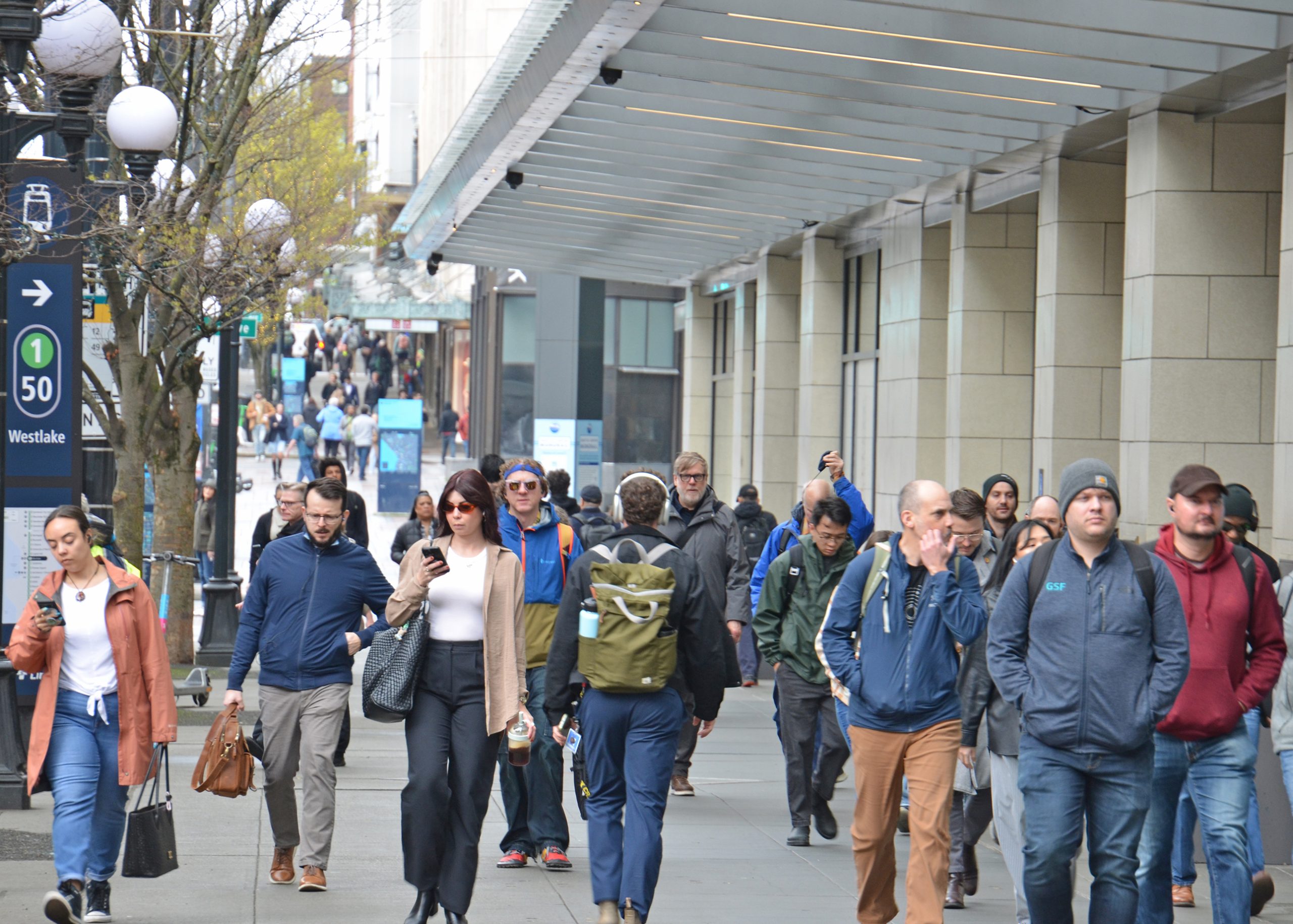News
The Registry: Downtown Seattle hits major recovery milestone with highest worker numbers since pandemic began
Posted on

This article was originally published by The Registry on April 16, 2025.
Downtown Seattle is experiencing a significant economic renaissance, with March 2025 data revealing the strongest recovery indicators since the COVID-19 pandemic first impacted the region five years ago. According to the latest Downtown Seattle Association (DSA) Revitalization Dashboard, multiple metrics point to a sustained and accelerating revival of the urban core.
Record-Breaking Worker Return
The most noteworthy achievement is the return of the downtown workforce. In March, downtown Seattle averaged nearly 101,000 daily workers—the highest daily average recorded since March 2020, when pandemic restrictions first emptied office buildings across the city. This figure represents 60 percent of the pre-pandemic levels seen in March 2019 and marks a substantial 12 percent increase from March 2024.
Industry analysts note this recovery is particularly significant given Seattle’s early pivot to remote work during the pandemic. The city’s tech-heavy economy allowed many workers to transition to home offices quickly, creating a steeper climb back for the downtown core compared to other major metropolitan areas.
Amazon’s recent policy shift requiring employees to return to the office five days a week has contributed significantly to this resurgence. In the South Lake Union and Denny Regrade neighborhoods—where Amazon maintains a substantial campus—daily worker foot traffic reached nearly 48,000 in March, representing 76 percent of March 2019 figures.
Visitor Numbers Approaching Pre-Pandemic Levels
Beyond the returning workforce, general visitor traffic shows equally promising trends. More than 2.5 million unique visitors came downtown in March 2025, representing 92 percent of the visitor levels seen in March 2019. This marks a 5 percent year-over-year increase and a 30 percent jump from February 2025, suggesting accelerating momentum as the weather improves and more events return to the downtown area.
Particularly encouraging is the data on local visitors—defined as people who live within 10 miles of downtown. This demographic is now visiting downtown at a rate of 104 percent compared to March 2019, indicating that nearby residents have fully embraced the revitalized urban core.
Hospitality Sector Continues Recovery with Minor Setback
The hospitality industry, one of the hardest-hit sectors during the pandemic, continues its steady recovery, with nearly 326,000 downtown hotel rooms sold in March 2025. This figure represents 93 percent of the demand seen in March 2019, though it does reflect a four-point decrease compared to March 2024—the only metric showing a slight year-over-year decline.
Industry experts attribute this minor setback to several factors, including lingering effects of inflation on leisure travel and shifts in business travel patterns as some companies maintain hybrid meeting policies. However, the upcoming cruise season and summer tourism surge are expected to offset these challenges in the coming months.
Residential Growth Remains Strong
Another positive indicator for downtown’s health is the continued growth in residential occupancy. In March, the number of occupied apartment units downtown rose to more than 59,000—representing a 4 percent increase compared to Q1 2024 and a remarkable 26 percent increase compared to Q1 2019. This residential growth provides a stable population base that supports retail, restaurants, and cultural venues regardless of office occupancy fluctuations.
Major Events Signal Return to Vibrancy
The timing of downtown’s accelerating recovery coincides with the beginning of Seattle’s busy event season. The 2025 cruise season has just launched, with the Port of Seattle expecting nearly 300 ship visits and 1.9 million revenue passengers this year—an industry that generates an estimated $900 million annually in local economic impact.
Several major events are also coming to downtown in April, including the 20th Asia-Northwest Cultural Education Association’s Sakura Con, which is expected to bring 35,000 attendees to the Seattle Convention Center April 18-20. Visit Seattle estimates this anime convention alone will generate $19.4 million in economic impact.
Other upcoming attractions include the Tony Award-winning musical “Parade” at The 5th Avenue Theatre (April 16-May 4) and the return of the Occidental Square Trading Post on April 26, featuring more than 30 local vendors selling handmade, antique, and vintage goods alongside live music and performances.
Leadership Perspective
Downtown Seattle Association President & CEO Jon Scholes expressed optimism about the mounting evidence of downtown’s revival: “The return of workers to downtown has hit another gear and you can feel it. Crowded sidewalks during the morning commute, lines out the door at coffee shops and an uptick in energy,” Scholes said. “While it’s just one component of our continued revitalization, the daytime weekday population is important for the health of our city. More workers mean more customers for small businesses, more patrons for our arts and cultural venues and a more vibrant urban experience.”
Scholes emphasized the importance of these concurrent positive trends: “We’re seeing trend lines heading in the right direction and the timing is terrific with the cruise season underway and a busy summer right around the corner. These are significant steps on the path to continued progress.”
Looking Ahead: Challenges and Opportunities
Despite the encouraging recovery metrics, downtown Seattle still faces challenges on its path to full revitalization. Office worker numbers remain at 60 percent of pre-pandemic levels, leaving a substantial gap that affects weekday business for restaurants, retailers, and service providers that traditionally catered to the office lunch crowd and after-work social scene.
Public safety concerns and transit accessibility continue to be areas of focus for downtown advocates and city officials. The DSA has been working with local government on initiatives to enhance safety, cleanliness, and transportation options to make downtown more welcoming for workers, visitors, and residents alike.
Nevertheless, the convergence of positive trends—increasing worker numbers, strong visitor traffic, robust residential growth, and the return of major events—suggests downtown Seattle has turned a significant corner in its post-pandemic recovery. The summer season, traditionally Seattle’s busiest period for tourism and outdoor activities, is positioned to further accelerate these gains.